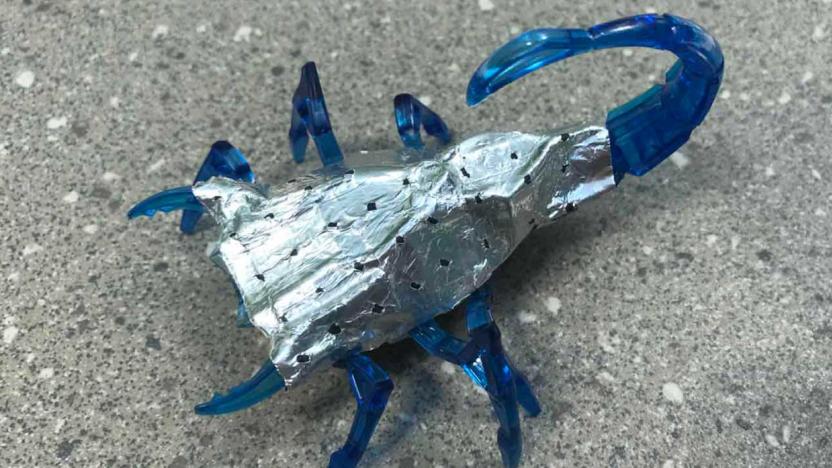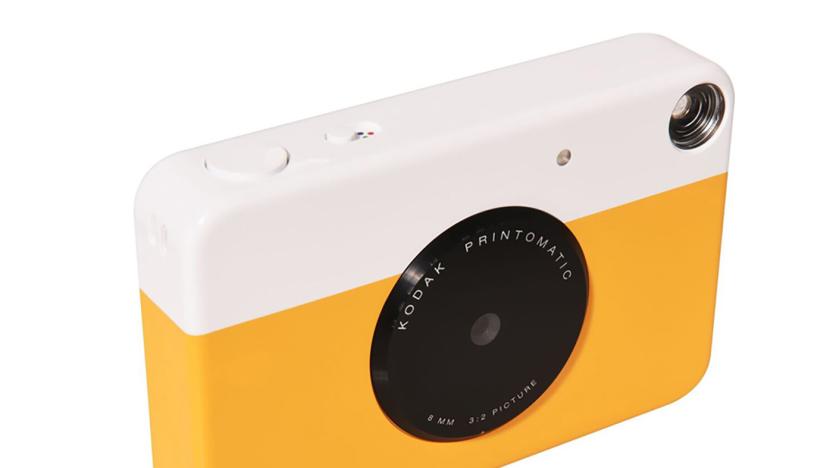zinc
Latest

Microsoft: State-backed hackers targeted COVID-19 vaccine creators
Microsoft says state-backed Russian and North Korean hackers have targeted seven COVID-19 vaccine creators.

This super strength body battery is made with discarded Kevlar
Today’s robot-mounted batteries provide electrical power but at the expense of added mass that in turn requires added power to move and use. Lithium-Ion batteries can go for around 500 cycles without noticeably degrading, however zinc batteries begin to decline after just 100.

Kodak channels Polaroid for its hybrid instant camera
I still remember how excited I was when my parents brought home a shiny Kodak instant camera, and how that turned to disappointment when it was recalled in a patent dispute with Polaroid (yes, I'm that old). I'm not nearly as excited with Kodak's latest instant camera, the Printomatic, though. That's because this time, it's nearly a carbon copy of Polaroid's Snap, introduced in 2015 and produced by a third company, C+A Global, that licensed Kodak's name.

IBM alliance sets efficiency record for solar power cells using common materials
There have been more than a few solar power efficiency records set in the past few months, let alone years. What makes IBM, DelSolar, Solar Frontier and Tokyo Ohka Kogyo think they can just waltz in and claim a record of their own? By using more commonplace elements in the periodic table, that's how. The partnership's new photovoltaic cell based on copper, zinc and tin (CZTS for short) can convert light rays to electric power with a 11.1 percent efficiency rate -- still nothing to upset traditional silicon power, but a large 10 percent more efficient than anything else in the class. In its early form, CZTS can already be manufactured through ink printing and could be produced in quantities equivalent to about 500 gigawatts of power per year, or five times more than some of the next-closest alternatives. The group wants to improve CZTS' efficiency over the course of the next several years, ideally reaching the point where it's useful as a truly cheap, ubiquitous source of power. We're looking forward to the day when there's a little slice of solar energy in just about everything, hopefully including a few more hybrid cars and private aircraft.

Captain's Log: Missed dev transmissions
Captain's Log, Stardate 64940.2... Hello, computer (and players)! As we have explored in past logs, the developers working on Star Trek Online are extremely transparent with the community, and this, surprising to some, is actually by design. Since Dan Stahl took over as Executive Producer a year ago come July, he made it his personal mission to make sure that fans of the game knew where the game was heading at all times and what was currently being developed. Due to the success of this open communication, Cryptic as a whole has made a shift to this philosophy for its other announced projects. New details often emerge through several different official sources: the monthly Ask Cryptic and Engineering Report as well as a plethora of interviews. While the previously listed outlets are often marketed and widely known about, there are several channels that I would like to bring to light, ones that seem to fall under the radar. As Twitter is one of the biggest social media crazes, developers are using it to get information and work-in-progress screenshots out to the public. Also, some devs seem to be sacrificing sleep, as we will often wake up to posts in the STO forums that were posted near the midnight hour of Cryptic's time zone. Many feel that the most interesting and drool-worthy information is found in these "leaks," so I would like to share some of them with you. Ensign, warp 10! You might want to grab a towel to wipe up your mouth...

NASA makes longer, straighter piezoelectric nanowires in microgravity, no flat iron needed
Piezoelectric nanowires are the stuff that make power-generating pants a possibility, and that prodigious potential has drawn the attention of NASA. You see, self-powered spacesuits are awfully attractive to our nation's space agency, and a few of its finest student researchers have discovered that the current-creating strands of zinc oxide can be made longer and straighter -- and therefore more powerful -- when freed from gravity's unrelenting pull. That means nanowires grown in microgravity could lead to higher capacity batteries and the aforementioned juice-generating interstellar garb. Of course, there's no such end-products yet, but let's see if NASA can do what others have not: give pants-power to the people.

Nanogenerators produce electricity by squeezing your fingers together, while you dance
It's been a while since we last heard about nanogenerators -- you know, those insanely tiny fibers that could potentially be woven into your hoodie to juice up your smartphone. Dr. Zhong Lin Wang of the Georgia Institute of Technology has reported that he and his team of Einsteins constructed nanogenerators with enough energy to potentially power LCDs, LEDs and laser diodes by moving your various limbs. These micro-powerhouses -- strands of piezoelectric zinc oxide, 1 / 500 the width of a single hair strand -- can generate electrical charges when flexed or strained. Wang and his team of researchers shoved a collection of their nanogenerators into a chip 1 / 4 the size of a stamp, stacked five of them on top of one another and can pinch the stack between their fingers to generate the output of two standard AA batteries -- around 3 volts. Although it's not much, we're super excited at this point in development -- imagine how convenient to charge your phone in your pocket sans the bulky battery add-ons. And that's only one application of this technology. Yea, we know.

ZeeVee releases Zinc TV browser for Macs
ZeeVee has announced a Mac version of its Zinc video browser. Aimed ata TV-compatible interface to any streaming website Zinc should run on any Intel Mac running OS X 10.5. Specifically pointing out boxee, Zinc says users can create access to new sites just by adding an rss feed to their favorites tab. Give it a shot and let us know if its as easy as they make it sound, Mac owners.Speaking of remote-focused interfaces for streaming sites, ZeeVee has announced a Mac version of its Zinc video browser. Aimed at the suddenly crowded field of giving a TV-compatible interface to any streaming website Zinc should run on any Intel Mac running OS X 10.5. Specifically pointing out boxee, Zinc says users can create access to new sites just by adding an rss feed to their favorites tab. Give it a shot and let us know if its as easy as they make it sound, Mac owners.

ZeeVee Zinc TV viewer hands-on and impressions
ZeeVee just let loose its Zinc internet TV viewer, and we couldn't help but give it an install on our Windows XP-based machine. While it can be said that this is a competitor to Hulu, it actually provides access to Hulu material. In that sense, maybe it's infringing more on boxee's territory. Underneath, it really relies on access to public video RSS feeds, so obviously the options are pretty limitless. If you're interested in seeing just how quickly you should download / avoid this new piece of software, follow us past the break for a few impressions.

ZeeVee releases retooled Zinc internet video browser
It's been a few months now since ZeeVee showed its soft(ware) side by announcing the free public beta of Zviewer, and now we're pleased to announce that it's back with a new name, a new face and a slightly revised agenda. Rechristened Zinc, this latest version is -- for all intents and purposes -- a competitor of boxee. Once installed on a PC (a Mac version should surface by April), users can easily navigate to tons of internet-based TV content from the likes of CBS, ABC, etc. Also of note, this version bakes in access to your Netflix Watch Instantly queue, providing access to 15,000 feature length movies and tens of thousands of TV shows. For now, ZeeVee's committed to keeping the application free, and it believes its superior UI will win folks over. The full release is waiting just past the break, and those interested in giving it a go should find a live download waiting right here.Psst... you can check out our hands-on and review over at Engadget HD.

Say it ain't so: O2 kills Xda Zinc
It's not terribly often that we're here to tell a sob story about a European carrier killing off a hotly-anticipated handset prior to release, but alas, it does seem to happen from time to time. Such is the case here, where O2 first delayed the ASUS-supplied Xda Zinc -- a rather delicious Windows Mobile QWERTY slider, if we do say so ourselves, replete with 3G data -- and now has apparently deep-sixed it entirely, claiming it wasn't up to snuff with its "testing requirements." To be fair, O2's Xda line of Windows Mobile-based devices is deep and wide enough to accommodate nearly any user's needs, Zinc or no, so we're not going to be sending any flowers or cards expressing our condolences. If anything, ASUS might be the one needing consolation here, with the Zinc possibly proving to be a breakout handset for the company in Europe's white-hot smartphone market.

O2 delays XDA Zinc launch until March
Just when you thought you'd waited long enough, and you were all set to hand over your credit card information for a shiny new XDA Zinc, you'll unfortunately have to gain just a little more interest on that dough and ponder whether or not you'll still be passionate about this thing come March. Although O2 was shooting for a January rollout for the slideout smartphone, interested customers are looking at another 1.5 to 2 months before they can get their palms on one. O2 is touting the XDA Zinc as a Mini S, but "with added 3G power for high speed internet / video calling," and it reportedly sports a QWERTY keyboard, 2.8-inch LCD touchscreen, 320 x 240 resolution, 520MHz PXA270 processor, 64MB of RAM, 128MB of flash ROM, two-megapixel camera, miniSD slot, Bluetooth 2.0, 802.11b/g, and of course, tri-band connectivity. Unfortunately, this well-spec'd device will indeed weigh you down a bit, as it tips the scales at 5.82-ounces and comes in at 2.3-centimeters thick. Still no word on pricing at this point, but just how special this thing will actually be in March remains to be seen.[Via RegHardware]






